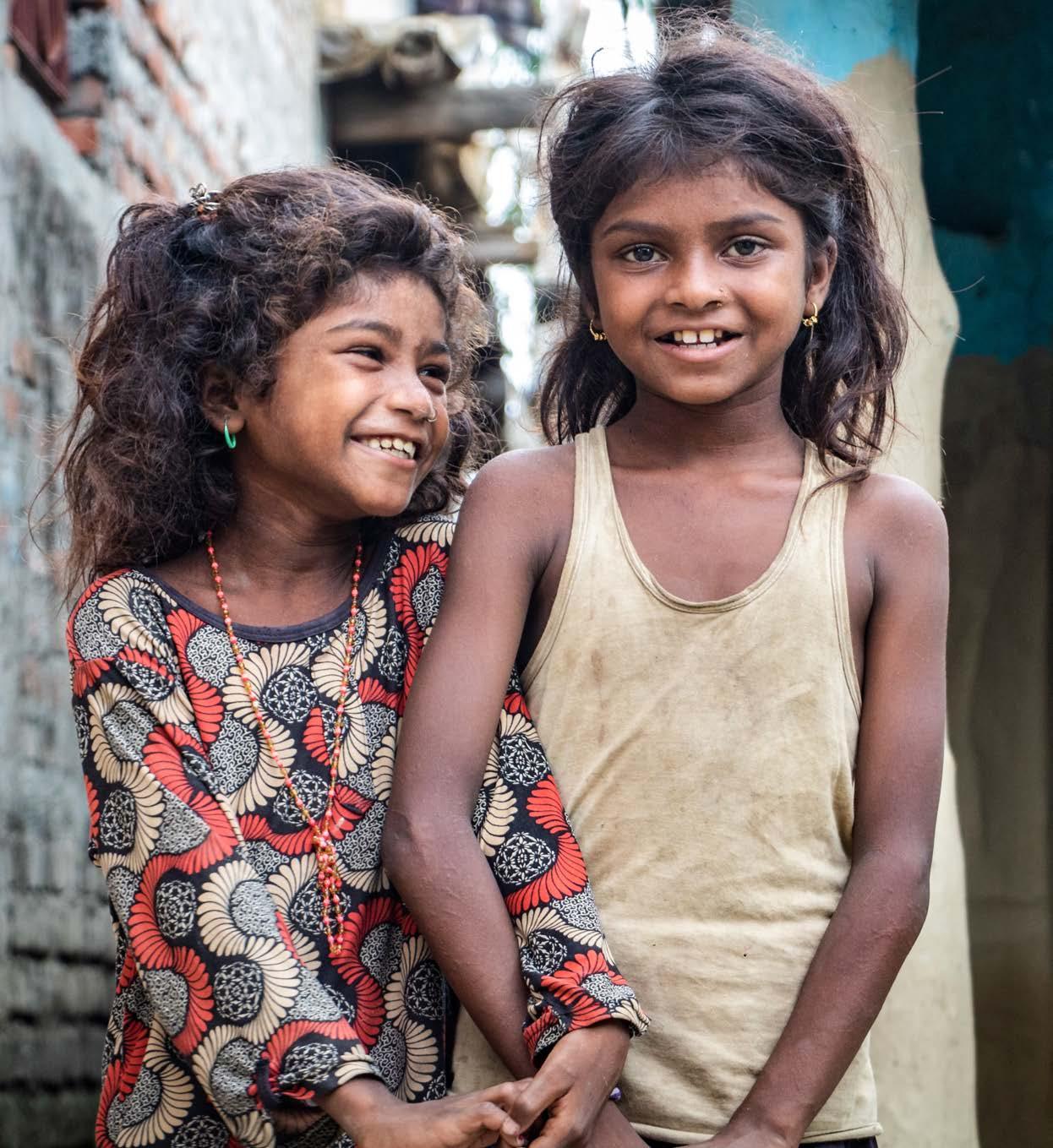

PROGRAMME INTERNATIONAL Save the Children Finland REPORT 2022


OUR 2030 AMBITION FOR CHILDREN
Save the Children is working to deliver a shared vision for 2030, focused on three breakthrough goals:
SURVIVE:
By 2030, no child will die from preventable causes before their fifth birthday
LEARN:
By 2030, all children learn from a good-quality basic education
BE PROTECTED:

This report serves as the 2022 annual programme report to the Ministry for Foreign Affairs of Finland under programme-based support. The views expressed in this publication do not necessarily reflect the views of the ministry.
Names of children and caregivers have been changed to protect identities.
Save the Children Finland © 2023
By 2030, violence against children will no longer be tolerated
Cover photo: In Nepal, Save the Children works to improve access of vulnerable families to social. protection with multiple positive outcomes.
Photo: Save the Children.
ABBREVIATIONS
4Ps - Pantawid Pamilyang Pilipino Programme
CP - Child protection
CRBP - Children’s Rights and Business Principles
CSSP - Child-Sensitive Social Protection
ECHO - European Civil Protection and Humanitarian Aid Operations
NGO - non-governmental organisation
VSLA - The Village Saving and Loans
FOREWORD
Save the Children Finland started 2022 on a very positive note, thinking that the first year of the new international programme would finally resume some normalcy after the COVID-19 pandemic. However, in February Russia attacked Ukraine, and the war following the attack cast a shadow over the programme countries, as well as Finland. The regional Ukraine humanitarian programme became our biggest new humanitarian response in 2022.
The human suffering in Ukraine mobilised people around the world to provide financial and other types of support to the affected population. Yet, in some of our programme countries, Russia’s narrative of the West being the evil, became popular. The war had global ramifications, and the price shocks, supply disruptions and food shortages triggered by Russia’s aggression made the interlinks increasingly noticeable. As a response to the aggression and threat posed by Russia, the discourse and policy objectives of Finland and the European Union took a turn to ensure the EU’s security and interests in a much stronger way.
As a response to the humanitarian needs in Ukraine, Save the Children intensified its support to the country, and that was done with the financial help of Save the Children Finland and the Finnish population. Unfortunately, the humanitarian needs increased massively also in other parts of the world but remained largely underfunded and under-reported.
Save the Children Finland’s growth has largely happened in the humanitarian sphere: In 2022, Save the Children Finland worked in several countries, such as in Afghanistan, Burkina Faso, Somalia, Sudan and naturally Ukraine, under an UN Humanitarian or Refugee Response Plan. The humanitarian situation in these countries was worsened by the increasing commodity costs, inflation and shortage of food items, seeds and fertilisers, which again multiplied the number of people facing hunger.
In the Horn of Africa and especially in Somalia, the fourth consecutively failed rainy season pushed even further people to severe levels of acute malnutrition. In many areas, people were facing famine-like conditions, although famine was not officially
declared. Extreme weather events are intensifying because of climate change, and the drought faced in Somalia, but also in West Africa and Asia in 2022 are reflections of that. Additionally, the number of people having to leave their homes due to weather-related events increased in 2022.
The increased humanitarian needs have demonstrated that Save the Children Finland’s nexus approach focusing on coherently addressing people’s vulnerability before, during and after crises, is the only way to achieve sustainable results. A good example of this is the ‘Education in Emergencies’ programming in Sudan, which also supported the ‘Safe Schools Declaration’ roll-out aiming to protect school education from occupation and ending attacks on education.
Despite the challenges and incredibly complicated operating environments, Save the Children Finland together with the country offices and partners achieved some great results: In 2022 we reached nearly half a million children (52% girls) and over 370 000 adults (63% women) in 14 countries.
The overall expenditure in 2022 was 32.58 million euros, which is 64.6% more than in 2021. This growth was possible on the grounds that the new programme was built on the achievements and learnings of the previous one. For example, Save the Children has adopted a flexible approach in the humanitarian response that makes it possible to quickly adjust emergency cash transfer values and diversify financial service providers to respond to changing circumstances on the ground. This approach helps to ensure access to essential resources and services in times of crisis for the most vulnerable populations.
The detailed results from 2022, and the lessons learned, are presented in this report. It’s all been made possible by our institutional donors, corporate partners and individual givers. We are grateful for their support and promise to keep working hard for as long as our work is needed.
Anne Haaranen Director, International Programme Save the Children FinlandOUR WORK IN NUMBERS 2022
495 042 CHILDREN REACHED
32.58 MILLION EUROS EXPENDITURE
14 COUNTRIES COVERED*
Programme countries of Save the Children Finland included in the Programme Based Support of the Ministry for Foreign Affairs of Finland
Other programme countries of Save the Children Finland
376 243 ADULTS REACHED
29 PROJECTS SUPPORTED
*Afghanistan, Burkina Faso, Côte d’Ivoire, India, Indonesia, Nepal, the Philippines, Russian Federation, Somalia, Sudan, Syria, Turkey, Ukraine, Zambia
CHILDREN REACHED DIRECTLY, CLASSIFIED BY PROGRAMME THEME
CHILDREN REACHED DIRECTLY, CLASSIFIED BY PROGRAMME THEME
CHILDREN REACHED DIRECTLY IN COUNTRIES, CLASSIFIED BY INCOME LEVEL
CHILDREN REACHED DIRECTLY IN COUNTRIES, CLASSIFIED BY INCOME LEVEL 9%
Health and nutrition
Child poverty Education
Child protection
CHILDREN REACHED DIRECTLY, CLASSIFIED BY REGION
CHILDREN REACHED DIRECTLY, CLASSIFIED BY REGION
Low income
Lower-middle income
Upper-middle income
ADULTS REACHED DIRECTLY, CLASSIFIED BY PROGRAMME THEME
ADULTS REACHED DIRECTLY, CLASSIFIED BY PROGRAMME THEME
Eastern and Southern Africa
West Africa
Southeast Asia
Central Asia
South Asia
Middle East and Europe
Health and nutrition
Child poverty
Child protection
Child Rights Governance Education
EXPENDITURE BY PROGRAMME THEME
EXPENDITURE BY PROGRAMME THEME, IN EUROS
EXPENDITURE BY REGION, IN EUROS
EXPENDITURE BY REGION, IN EUROS
Food Security /Cash and Voucher Assistance
Education
Health and nutrition
Child protection
Child-Sensitive Social Protection
Support to Save the Children humanitarian operation
EXPENDITURE BY THE DEVELOPMENT STATUS OF COUNTRIES, IN EUROS
EXPENDITURE BY THE DEVELOPMENT STATUS OF COUNTRIES IN EUROS
Eastern and Southern Africa
Middle East and Europe
West Africa
Southeast Asia
South Asia
EXPENDITURE BY INCOME LEVEL OF COUNTRIES, IN EUROS
EXPENDITURES BY INCOME LEVEL OF COUNTRIES, IN EUROS
Least developed countries Other countries
EXPENDITURES BY OPERATIONAL CONTEXT, IN EUROS
EXPENDITURES BY OPERATIONAL CONTEXT, IN EUROS
Low income
Lower-middle income
Upper-middle income
Humanitarian
Non-humanitarian
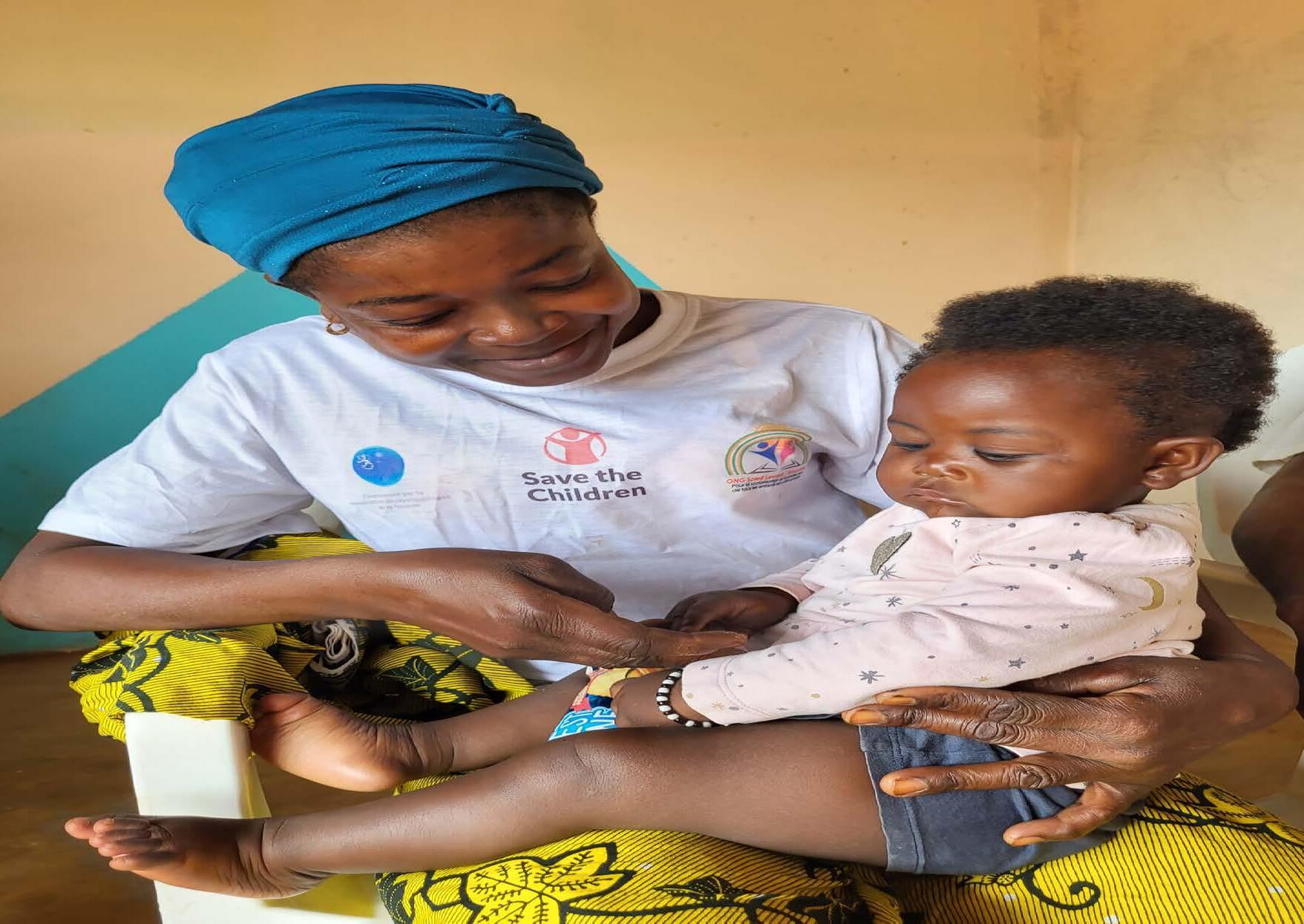 Photo: Katja Selkimäki -Gray/ Save the Children
Photo: Katja Selkimäki -Gray/ Save the Children
2. OPERATIONAL CONTEXT: THE IMPACT OF CHANGES IN THE WORKING ENVIRONMENT
2.1. West Africa
BURKINA FASO
The humanitarian situation in Burkina Faso is characterised by recurrent shocks, such as conflicts and natural disasters, compounded by the impacts of climate change. The crises continue to intensify as population movements and human rights violations increase.
In December 2022, about one in ten Burkinabe —1.9 million people, many of whom are children and adolescents — were internally displaced, making Burkina Faso the most affected country in the Sahel in terms of internal displacement. The other main consequence of the armed conflict and climate change is the chronic food and nutrition insecurity Burkina Faso has been facing for nearly a decade. The humanitarian situation in Burkina Faso in 2023 is more worrying than ever.
During 2022, Burkina Faso experienced two coups d’état both dissolving the government and suspending the constitution, resulting in restricted civic space. Limitations to freedom of expression and association were observed following the last coup
Burkina Faso is one of the world’s most neglected crisis. At the end of 2022, almost 1,9 million people were displaced due to conflict, drought and food insecurity. Save the Children supported the livelihoods of families and distributed essential non-food items as part of its EU funded emergency food security project.
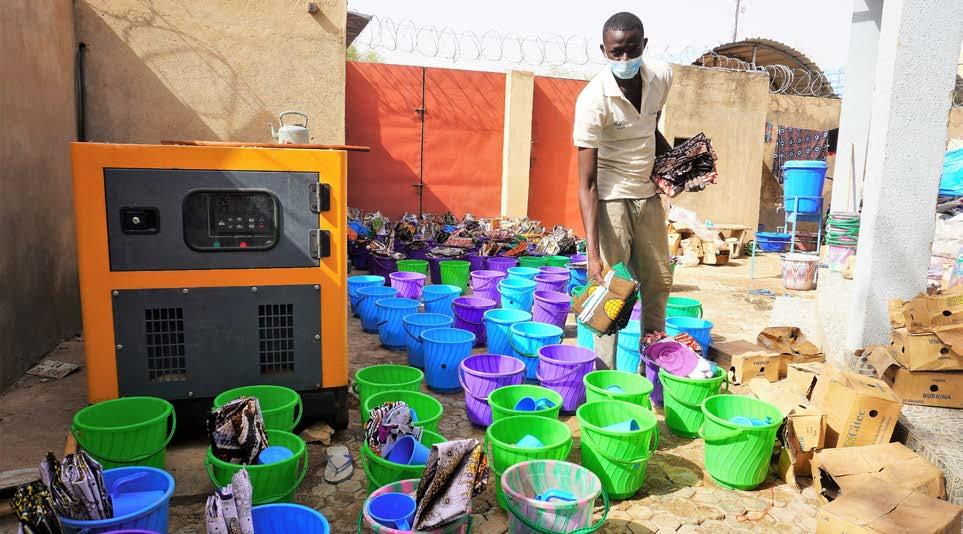
in September. Despite the difficult operational environment, Save the Children was able to implement most of its planned activities, but the deteriorating security situation caused challenges.
The EU funded emergency food security project for internally displaced persons and the most vulnerable host households in the Sahel region of Burkina Faso was extended by two months due to delays in construction activities arising from the challenging security context. However, thanks to the no-cost extension and the efficient actions by Save the Children, the project managed to reach more than 5000 extra beneficiaries than originally foreseen.
Our UNICEF funded Child-Sensitive Social Protection (CSSP) project combatting child poverty and vulnerabilities in four regions of the country also faced challenges due to armed attacks. Some project equipment was also stolen in an armed attack.
CÔTE D’IVOIRE
Côte d’Ivoire has gone through more than a decade of instability due to numerous political and military crises. Such tensions have slowed down the country’s economic and social development. Despite these challenges, Côte d’Ivoire has succeeded in becoming an economic hub in French-speaking West Africa and is one of the fastestgrowing economies in the world.
In 2022, the Ivorian economy recorded GDP growth estimated at 6.7% and remains on a positive economic trajectory. Additionally, in the UNDP report the same year, Côte d’Ivoire finally reached the category of countries with a medium level of human development, ranking 159th among 191 countries.
The country remains politically stable with no major incidents since the end of the tensions generated by the 2022 presidential elections. However, CIVICUS has categorised Côte d’Ivoire’s civic space as obstructed. Civic space has allowed civil society organisations (CSOs) to operate freely in the country. Local state actors, who are aware of their
limitations, rely on active partnership with the CSOs to deliver assistance to vulnerable populations.
In 2022, Save the Children and its local partners are operating in more than 20 localities in the North-Eastern Gontougo region to strengthen child protection mechanisms and CSSP. Despite the pre-identified socio-cultural barriers, the communities and local authorities are particularly involved and committed to the proposed activities. However, northern Côte d’Ivoire has recorded 13 jihadist attacks in Bounkani and Tchologo regions since 2020, which makes the security situation and operating context in the area more challenging.
2.2. Eastern and Southern Africa
SUDAN
Sudan continued the efforts to restore the political situation after the military coup in October 2021. Ongoing tensions between civilians and the military persisted, and local outbreaks of violence and conflicts have undermined the efforts to protect civilians and enhance social cohesion. The situation in Sudan was further exacerbated by the economy continuing its downward spiral and sliding into recession.
High levels of displacement due to the ongoing conflict and political instability has led to the loss of livelihoods and food reserves increasing the displaced populations’ vulnerability. This has generated record-high numbers of food-insecure people, peaking at 11.7 million.
After the former dictator al-Bashir was ousted in 2019, the country started a path towards democratic transition. Yet, Sudanese civil society groups are facing increased restrictions —equal to the
conditions during the former regime— on civic space and rising repression. Given the ongoing tensions and the military rule, Sudan has been rated as repressed by CIVICUS Monitor.
Humanitarian needs in Sudan are at an all-time high resulting in more than a third of the country’s population —14.3 million people— requiring humanitarian assistance. Around 9 million depend upon emergency assistance for life-threatening needs related to physical and mental well-being. Sudan also faces the threat of natural disasters, particularly floods, causing wide-scale damage to homes and infrastructure. Riverine and flash floods are recurrent seasonal natural disasters in Sudan affecting more than 350 000 people every year.
Despite the pause in donor development funding resulting from the military coup, Sudan Country Office achieved a major success in securing a direct EU grant of 30 million euros for the ‘Education, Child
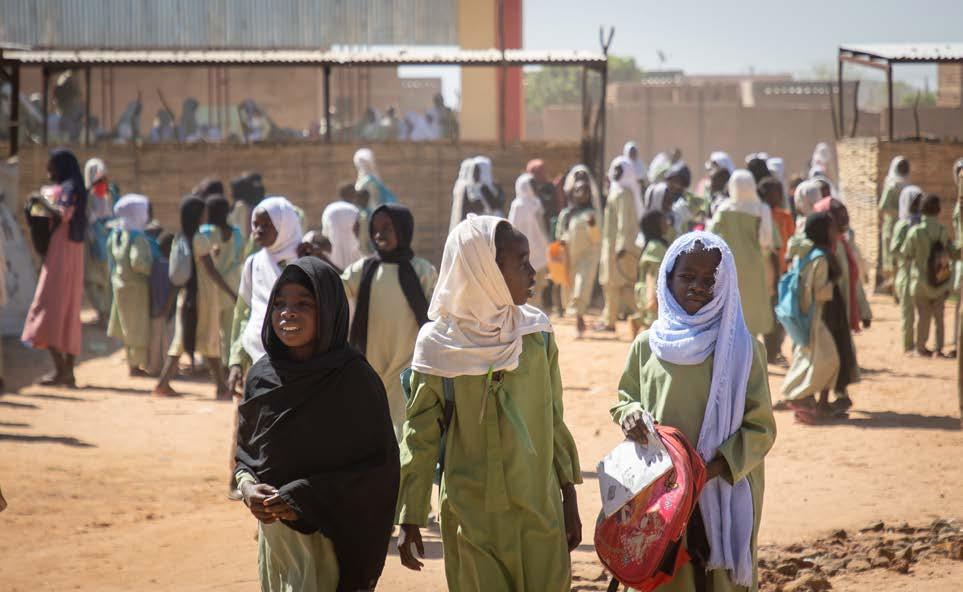
Rights and School Feeding’ programme. Thanks to the proactive country-led engagement, the nearly two-year long process convinced the EU Delegation in Sudan that Save the Children is the best placed Education partner.
ZAMBIA
After years of economic progress, including achieving the lower middleincome status in 2011, Zambia’s economy has stalled, and the country now has among the highest wealth inequality in the world. More than half of Zambia’s population live below the poverty line.
The operational environment in Zambia remained favourable and stable throughout 2022. The engagement with the government continued
positive despite CIVICUS categorising Zambia’s civil society space as obstructed. Laws, such as the ‘NGO Act’, continue to exist, which challenge civil society organisations’ liberties and freedom of assembly. Also, the funding to civil society has seen a steady decline, while perceived economic growth has failed to translate into inclusive and sustained economic development.
Zambia is already experiencing the full impacts of the climate crisis in forms of extreme weather conditions such as droughts, floods and landslides, which makes the country among the most vulnerable to climate change. Zambia’s slow and silent climate crisis has already driven around 13% of the population —1.58 million people, including over 820 000 children— into severe food shortages.
On a positive note, the government enacted the ‘Children’s Code Act’ seeking to strengthen the legal framework to promote, protect and fulfil the rights of children. Save the Children, along with other child focused organisations, held several policy advocacy initiatives with key actors throughout the year to ensure the enactment of the Act.
The government also introduced free education from pre-primary to secondary level which is likely
to increase access to education and counteract negative vices such as early and forced marriages and child labour. Similarly, the Zambian government increased the workforce in the education and health sectors by 30 400 teachers and 11 200 health workers.
In 2022, Zambia also hosted the first ever African Children’s Parliament providing an opportunity to amplify various issues affecting children.
SOMALIA
The humanitarian situation in Somalia continued to deteriorate in 2022. Severe drought, hunger, disease and violence have all resulted in almost half of the population —over 8 million people, 4 million being children— requiring humanitarian assistance.
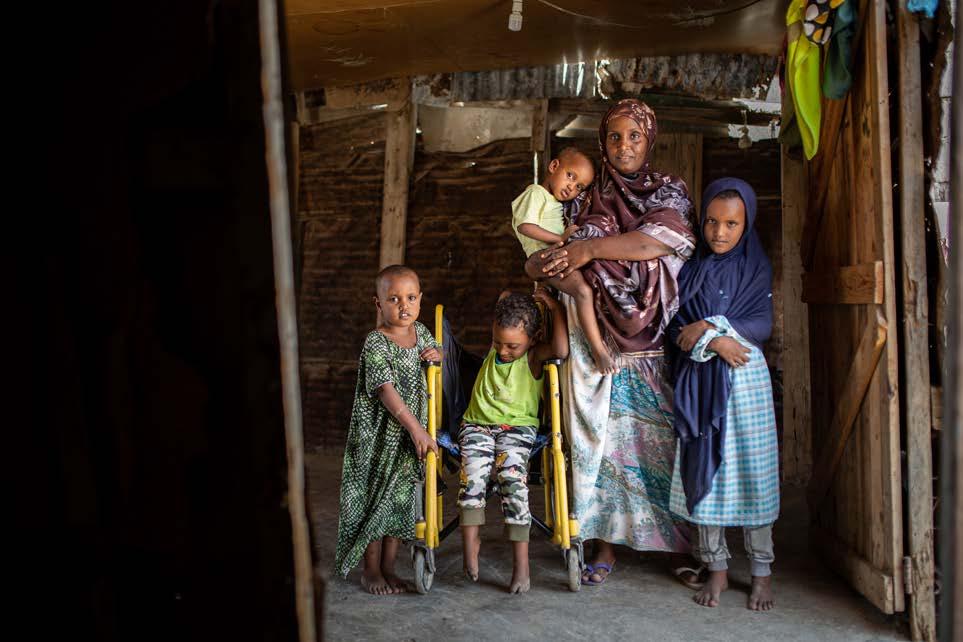
Continuous failed rainy seasons have made the current drought the longest in recent history. Drought-induced displacement has increased fivefold leaving more than 1.3 million people displaced at the end of 2022. The drought is also resulting in
In Somalia, the humanitarian situation continued to deteriorate during 2022. Almost half of the population were in need of humanitarian assistance and protection at the end of the year. Kama, a mother of eight children in drought-stricken Berbera, was one of the affected. With support provided by Save the Children and partner organization YOVENCO, she was able to ensure medical assistance to one of her sons, who is disabled.
widespread death of livestock and a devastating food crisis. Humanitarian needs continue to grow disproportionately for marginalised and vulnerable groups. According to UN Office for the Coordination of Humanitarian Affairs, Somalis are “hungrier, sicker and more vulnerable than a year ago”, pushing an evergreater number of people into reliance on humanitarian assistance for survival.
The security situation in Somalia remains extremely volatile. The ongoing crisis and displacement of people in the region has led to an increase in child abuse and gender-based violence. Many children are either neglected or separated from their families, and families rely on negative coping mechanisms, such as taking children from school and putting them into work, or even child marriage. Overall, UN expects that up to 450 000 additional civilians will be displaced due to conflict in 2023.
In light of these challenges, a major success in 2022 was the approval of the long-waited Somaliland ‘Child Act’. The Act profoundly underlines the rights of children and ways to protect them. Save the Children has worked in collaboration with Somaliland Ministry of Employment, Social Affairs and Family to build towards this child rights bill since 2011.
2.3. Asia
The beginning of 2022 saw many Asian countries imposing severe and longlasting COVID restrictions, including school closures, to contain the spread of the Omicron variant. The disrupted education of tens of millions of children caused significant learning loss. Later on in the year, the elections in Nepal and in the Philippines resulted in postponing and suspending some of the project activities.
The Philippines was one of the last few countries to transition back to face-to-face learning in August 2022. The impact of the pandemic-induced school
closure is now more evident than ever: More than 90% of Filipino children struggle with reading and understanding simple texts at the age of 10. In Indonesia, the extended school closures and disrupted education of around 60 million children caused significant learning loss.
In India, the findings of a study by Save the Children showed that the pandemic’s mental and physical impact on children has been severe and incredibly harmful. Lockdowns did not only lead to reduced socialising amongst children, but also increased the intensity of different emotions that parents and children were feeling. This brought a complex array of challenges that had mental health repercussions for both children and adolescents.
All programme countries in Asia have civil society space which is classified as repressed or obstructed. According to CIVICUS, water cannons and tear gas were used against people protesting fuel price hikes amid soaring inflation in September in Indonesia. The country’s press freedom ranking has also dropped further, and there are reports of digital repression.
In India, the authorities have continued to block access to foreign funding for non-governmental organisations (NGOs) using the restrictive ‘Foreign Contribution Act’ due to which organisations like Save the Children are unable to fully engage with local partner NGOs. The law has been made increasingly draconian, despite the criticism by the international community, as stated by CIVICUS.
Project activities postponed due to elections
In 2022, elections took place in Nepal and in the Philippines. In Nepal, increased efforts were needed post-elections to re-establish the coordination and set up linkages with the newly elected local government representatives. Prior to the elections in the Philippines, there was an air of uncertainty on the implementation of project activities in some project areas. Contingency plan was developed to mitigate possible resistance from the newly elected officers. In one of the municipalities, the new mayor suspended all project activities until a Memorandum of Agreement was forged between Save the Children and the municipality.
In Nepal, the government continued to strengthen its social protection programmes and policies. Rajiya, 42, is a widow and a mother of four girls. She was supported to access social protection, and to get a birth certificate for her youngest child. “I look forward to sending my daughters to school after I start receiving my widow allowance.“
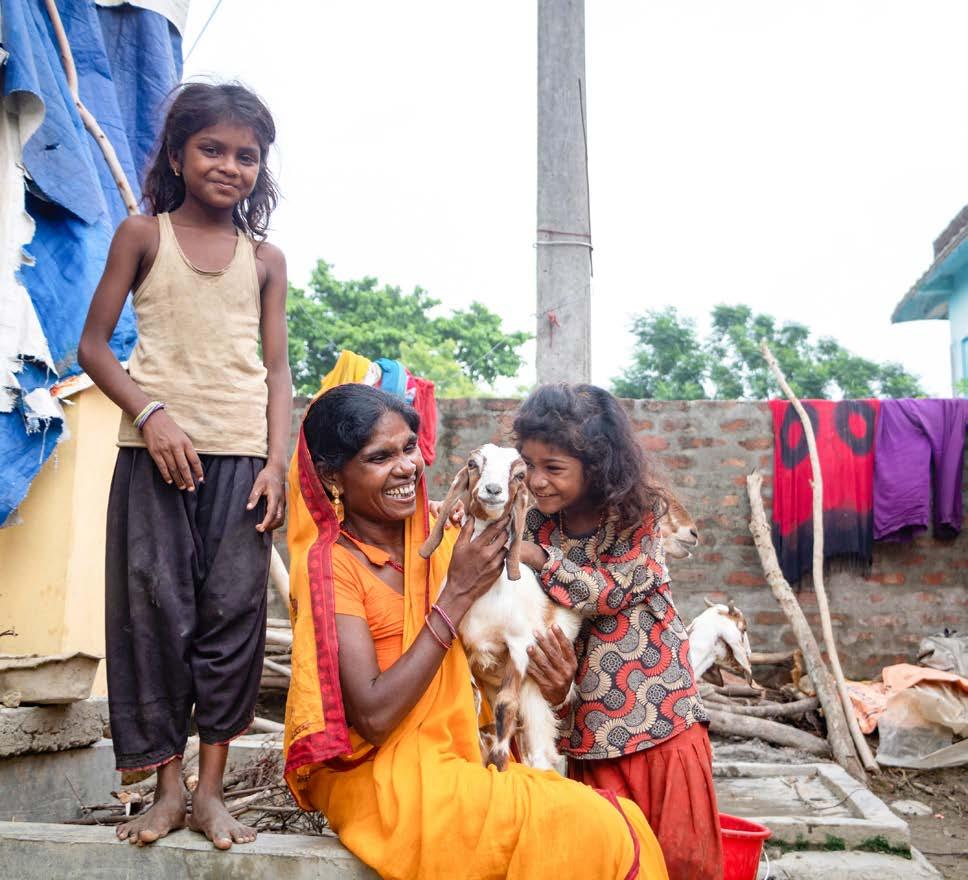
In Nepal, the government policy directed international NGOs to implement the projects through local partners. As a result, Save the Children changed the modality of project implementation, while some of the project activities were implemented through municipalities the year before.
Positive steps were taken to promote social protection programmes in Nepal, when the project signed
a Memorandum of Understanding to collaborate with the national department in charge of delivering social protection schemes. As a result, the department endorsed and circulated the ‘Child Grant’ plus parenting model standard to all local governments.
2.4. Humanitarian: Afghanistan
Following the massive deterioration after the de-facto authorities takeover in 2021, Afghan women and girls faced unique vulnerabilities and risks as gender inequality is interwoven with the conflict dynamics and humanitarian needs.
Over the past years, Afghanistan has experienced a devastating combination of drought, conflict, political upheaval and successive waves of COVID-19 infections exacerbated by economic restrictions. This intersected with longstanding vulnerabilities and has put unprecedented pressure on the livelihoods and the food security of Afghans across the country.
The roll-back on women’s rights and restrictions on their participation in life and society, with
impositions introduced on education, right to work and freedom of movement of girls and women, further worsened the economic crisis and created barriers to access services. On top of this, in December 2022, the NGO coordination body in Afghanistan received a letter from the Minister of Economy informing national and international NGOs that, with immediate effect, they are prohibited from employing female staff.
The ban on female NGO workers —on top of existing restrictions— made it extremely difficult for organisations to serve and support communities, despite the needs being huge. Save the Children Afghanistan’s needs assessment from August 2022 showed that 97% of families were struggling to provide enough food for their children. With 47% of the population being under 15 years old, the crisis in Afghanistan is hitting children —and especially girls— hard.
3. STRATEGIC FOCUS AND PROGRAMME OUTCOMES
3.1. Programme progress in short
In 2022, a strong emphasis was put on scaling up our achievements from the last programme period. We invested in establishing programmatic baselines in all of our programme countries and themes as well as building capacity of our local partners and authorities in child poverty thematic work. A specific focus was put on both the child sensitivity of social protection and cash transfer programming.
We were also strongly engaged in Child Protection (CP) and, more specifically, in developing community-based CP systems in our key countries Burkina Faso, Côte d’Ivoire, Somaliland/Somalia and Zambia. All CP projects are providing and supporting both prevention and response CP services.
The following programme outcomes are presented across the programme themes of Child Protection, CSSP, Food Security and Livelihoods (FSL), Education and Health and Nutrition:
n Improved access to services for children and families (all themes)
n Improved child development and protection (CSSP, CP and FSL)
n Improved child and gender sensitivity of services, systems, policies and programmes (CSSP and CP)
PROGRESS TOWARDS OUTCOME
1: Children and families’ access to services improved both in quality and quantity
In 2022, we continued to support disadvantaged groups and communities to access social protection programmes across India, Nepal and the Philippines in Asia and Zambia and Somaliland/Somalia in Africa. As an effort to strengthen the social protection system, we have initiated the development of ‘Standard Operating Procedures’ in Asia to support the upscaling of access to social protection and related services.
In Child Protection we measure annually the satisfaction of the services the children and their caregivers received. In 2022, there was a clear improvement from baseline in our target countries: The satisfaction increased for instance in Somaliland from 45% to 75% and in Burkina Faso from 77% to 100%.
Unconditional cash transfers —payments that provide autonomy to the cash recipients over their use— have consistently improved both the quality and the quantity of food consumed among crisis-affected populations in our target countries.
Additionally, a successful ‘Safe Back to School’ campaign exceeded enrolment targets in all Education project locations in Sudan.
PROGRESS TOWARDS OUTCOME 2: Improved child development outcomes and protection of children through strengthened child and gender sensitivity of caregivers, children and community
In 2022, we integrated the ‘Safe Families’ programming in all of our CP interventions. On average 74% of children who have participated in the ‘Safe Families’ programme have improved their psychosocial wellbeing. Moreover, 73% of them report having improved positive interaction with their caregivers.
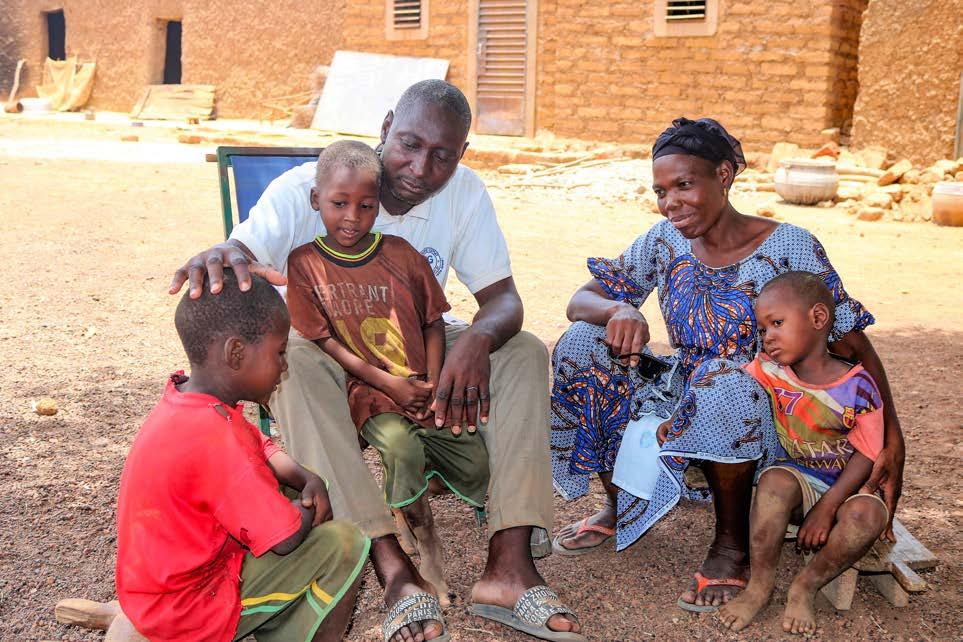
Baseline studies showed relatively low confidence among community members in their ability to prevent and respond to child protection risks in the four target countries (Burkina Faso, Côte d’Ivoire, Somaliland and Zambia), which confirmed the importance of our work in this result area.
In our CSS) projects, baseline data collection on early childhood development indicators using ‘Caregiver Reported Early Development Indicators’ was executed in India, Nepal, the Philippines, Zambia and Somaliland. The data will be analysed and presented as a comparison between intervention and control groups once the endline data has been collected.
Multipurpose cash assistance was implemented in five projects in Sudan, Somalia and Burkina Faso: More than 85% of the households receiving the cash assistance reported that it was delivered in a safe, accessible, accountable and participatory manner, even in volatile security conditions. Furthermore,
the majority of the beneficiaries reported an improved ability to meet their basic needs, thanks to the assistance.
PROGRESS TOWARDS OUTCOME 3: Improved child and gender sensitivity of services, systems, policies and programmes
At the core of our work in 2022 was to build child and social protection systems at national levels for programme results to be upscaled and maintained. We invested in capacity building of the social workforce and supported child protection coordination mechanisms at local, regional and national levels.
Recommendations related to making social protection policy and practice child-sensitive were pursued in different project countries, for example, Save the Children in partnership with Zambia Institute for Policy Analysis and Research (ZIPAR) undertook a review of the national social protection policy in Zambia from a child sensitivity lens and the recommendations have been acknowledged by the
government’s technical working group drafting the new social protection plan. In Somaliland, we supported the Ministry of Employment, Social Affairs and Family draft a social protection policy which has been translated into Somali and submitted to the cabinet for approval.
Two important child protection laws were finalised in 2022: the ‘Child Right Act’ in Somaliland and the ‘Children’s Code Act’ in Zambia. Save the Children and its national partners played a crucial role in advocating and supporting the work leading towards both legislations over several years.
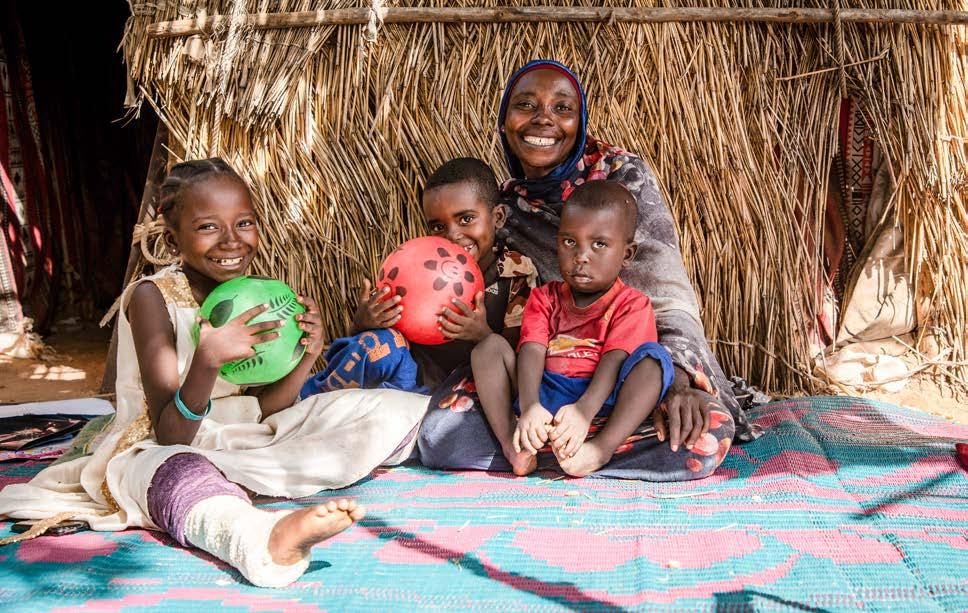
In 2022, Save the Children Sudan rolled out the ‘Safe Schools Declaration’ in three states (West Darfur, Blue Nile and South Kordofan) with the aims of protecting school education from occupation and ending attacks on education. 30 bodies signed the State Commitment, among others military forces, inattention organisations, UN agencies and community leaders.
Mariam was seriously injured when armed assailants attacked her home village in Darfur, Sudan. Initially she refused to speak due to phycological trauma. Save the Children provided Mariam with medical care and psychological support. Also, her mother received livelihoods support through the health and nutrition project funded by EU.
3.2. Child-Sensitive Social Protection
Save the Children has been working with Child-Sensitive Social Protection across Asia and Africa for a decade, and thus gained substantial results and evidence of improved development outcomes for children. Our goal is to help vulnerable and poor populations 1) access social protection benefits, 2) improve child development outcomes through our parenting/child sensitivity interventions, and to 3) promote children’s rights in governmental social protection strategies, policies and programmes.
In 2022, we kickstarted the 2022-25 phase of our programming with interesting interventions and baseline studies focusing on child development status that will help measure the impact of the programme in a robust manner. Below are a few snapshots of the progress made towards the outcomes.
PROGRESS TOWARDS OUTCOME 1: Children and families’ access to services has improved
We worked closely with local and national governments in Nepal, the Philippines, India, Zambia, Somaliland and Côte d’Ivoire to enhance their understanding on effective ways to support people accessing social protection programmes. We upscaled the initiatives to additional geographical areas and focused on institutionalising the approaches developed for accessing social protection programmes based on inclusion, transparency and accountability ability.
In the Philippines and Nepal, the development of Standard Operating Procedures (SoPs) was initiated to support the upscaling of access to social protection and related services.
PROGRESS TOWARDS OUTCOME 2: Improved child development outcomes and protection of children through strengthened child and gender sensitivity of caregivers, children and community
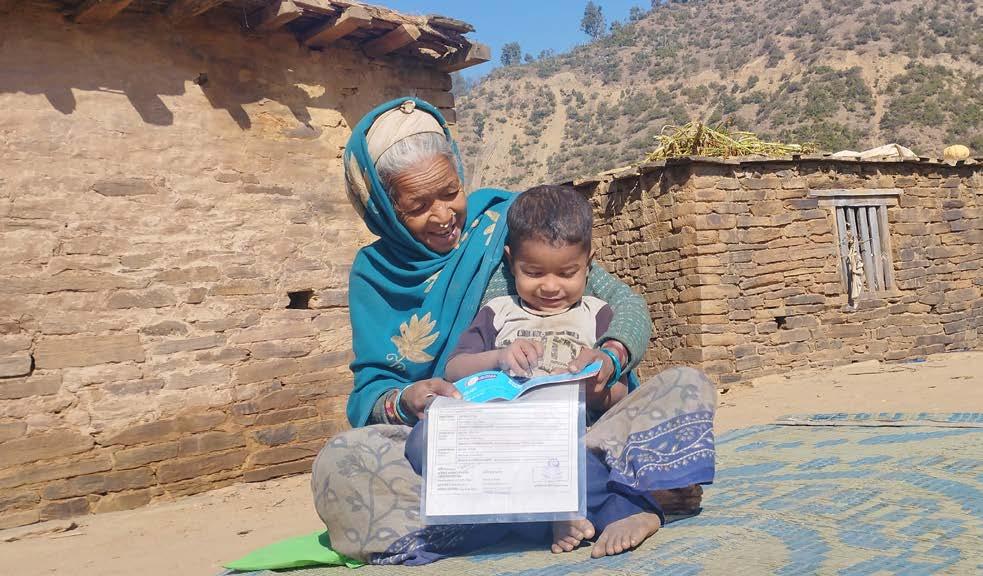
Marwa, a 10-year-old girl, is one of the children reached by the CSSP project implemented in Somaliland. The family received a periodic child grant, while both Marwa and her mother took part in trainings offered to allowance recipients. “My mother said that she will use the child grant for my education, and she fulfilled her promise.”

Baseline studies were undertaken in all CSSP projects across Asia and Africa.
In Côte d’Ivoire the school dropout rates were 14.21% and negligible among the target groups in Zambia and Somaliland. Anthropometric measurements revealed that 14% of children in the project area in Nepal, 29% in India and 15.1% in Somaliland were underweight.
Data on early childhood development indicators in India, Nepal, the Philippines, Zambia and Somaliland was collected using the ‘Caregiver-Reported Early Childhood Development Instrument’, and on social and emotional learning in Somaliland and Zambia using the International ‘Social and Emotional Learning Assessment’. These tools are most useful when comparing gains made in different childhood development domains and social emotional learning, pre and post intervention. Therefore, the baseline data collected using Caregiver-Reported Early Childhood Development Instrument and International ‘Social and Emotional Learning Assessment’ tools will be analysed and presented as a comparison between intervention and control groups once the endline data has been collected.
Baseline data was also collected with children to better understand maltreatment practices and parental engagement. The data suggests that children do experience widespread maltreatment and rather limited parental engagement. For instance, in India the maltreatment score was 2.33/4, slightly higher score among girls than boys, and in Somaliland 2.64/4. Whereas the parental engagement score was 0.82/4 (with no difference in reporting between boys and girls) and 1.52/4 respectively.
The implementation of the CSSP based parenting programme continued with 1104 participating parents/ caregivers in existing project areas in India, Nepal, in the Philippines and Somaliland/Somalia. In Zambia and Côte d’Ivoire 47 parenting facilitators were trained on parenting based on the International Child Development Programme, and the roll out of the parenting programme will start in the beginning of 2023.
A new CSSP intervention was initiated in Côte d’Ivoire with a series of capacity building workshops and trainings on social protection, CSSP, transparency and accountability promotion and International Child Development Programme for Save the Children International project staff, partner NGO and government representatives.
PROGRESS TOWARDS OUTCOME 3: Improved child and gender sensitivity of services, systems, policies and programmes

During 2022, various cash plus approaches were developed. Simultaneously, we pursued recommendations related to making social protection policy and practice child-sensitive in different project countries. Below are a few examples.
A. From piloting to scaling up by the governmentCase the Philippines
In the Philippines, our key CSSP initiative is to make the national flagship social protection programme —The Pantawid Pamilyang Pilipino Programme (4Ps), reaching 4 million households— more impactful for children. The 4Ps is a government social protection programme that provides monthly cash to poor households with children in order to promote their development.
Our intervention focuses on strengthening the parenting skills of the 4Ps beneficiaries so that their interactions with children are based on behaviours, which stimulate the holistic development of children. The intervention has been carried out in close collaboration with the Department of Social Welfare and Development (DSWD) responsible for the 4Ps.
An agreement has now been signed between DSWD and Save the Children Philippines to upscale the parenting programme nation-wide so that all 4Ps households can benefit from it.
B. Making national social protection policy and strategy child-sensitive - Case Zambia
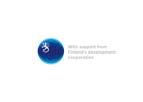
The Government of the Republic of Zambia considers social protection as the key strategy to support inclusive economic growth while contributing directly to poverty and vulnerability reduction and the promotion of equity and fulfilment of human rights.
The National Social Protection Policy and its accompanying implementation plan came to an end in 2019. The National Social Protection Policyis being reviewed as we speak, and the Zambian government plans to update it with current and emerging issues,
such as the cash plus concept, single window initiative promoting social protection programme integration across various ministries and stakeholders as well as shock-responsive elements of social protection, which bring focus on shocks that affect a large proportion of the population simultaneously (covariate shocks).
The review of the National Social Protection Policy provided an opportunity for Save the Children to raise critical issues and gaps in the existing policy. We assessed the policy from the child-sensitive and children’s rights perspectives in partnership with the Zambia Institute for Policy Analysis and Research (ZIPAR). The review focused on eleven dimensions of child sensitivity, including 1) expenditure, 2) coverage and exclusion, 3) acceptability, 4) adequacy, 5) appropriateness, 6) adaptability, 7) acceptability, 8) transparency and accountability, 9) responsibility and complementarity as well as 10) participation and 11) impact.
Our findings and recommendations have been acknowledged by the government’s technical
working group drafting the new plan, and the Ministry intends to conduct wider consultations to collect input from all stakeholders, including Save the Children.
C. Supporting national government to develop its social protection policy - Case Somaliland
Somaliland does not have a legal or policy framework for social protection, although the second National Development Plan of Somaliland sets out a vision for social protection “to reduce extreme poverty, discrimination, inequality and to ensure everyone has access to all basic needs/services through an appropriate social protection system”
Building on the National Development Plan of Somaliland II, Save the Children has made a continuous effort with the Ministry of Employment, Social Affairs and Family to develop a social protection policy for Somaliland with the strategic aim to ensure the vulnerable population’s access to social protection. These efforts consist of intensive capacity building of the government officials and newly elected Members of Parliament (MPs) and organising public dialogue on government’s prioritisation of funding. This has led to drafting of a social protection policy, which has been translated into Somali and submitted to the cabinet for approval.
Key strategies towards sustainability
The key strategy for implementing CSSP initiatives has always been forging strong partnerships with local, regional and national governments across the project countries. This partnership is important since in most cases we are working to strengthen the governmental social protection system. Targeted capacity building and strengthening measures, such as training the staff of government line ministries and departments as well as community-based institutions, form an integral part of this strategy.
The CSSP programme also establishes and/or strengthens existing transparency and accountability mechanisms as a regular practice. This further facilitates community members’ direct engagement with duty bearers to access social protection bene-
fits and basic services on a regular basis.
Key thematic learnings
At Save the Children, we understand that cash alone is not sufficient to sustainably reduce poverty. However, it is a necessary foundation, and when provided alongside access to basic services and complementary interventions, such as ‘Cash Plus Parenting’, cash transfers can be transformational in breaking the intergenerational cycle of poverty.
Given the huge interest and acceptance by Save the Children country offices, various governments and donors in the CSSP parenting approach developed by Save the Children Finland, initial steps have been taken to develop it into a Save the Children movement-wide common approach.
3.3. Child Protection
Our work aims to prevent violence against children and to respond to a diverse range of child protection risks and harms. We supported 1) access to high-quality child protection services, 2) strengthened caregivers’ and communities’ knowledge and skills to protect children, 3) advocated for laws and policies and 4) worked with vulnerable girls and boys, so they know how to protect themselves and their peers.
In 2022, we supported the revision of the parents’ and children’s sessions in our ‘Safe Families’ programme and advocated for children’s safe and responsible use of the internet. We participated in the case management toolkit review process as well as advocated for the revised ‘Quality of Service Indicator’ to be used as a key indicator to measure and inform our Child protection system strengthening (CPSS) programmes globally. We also adapted CPSS guidance to the French and francophone West African context.
PROGRESS TOWARDS OUTCOME 1:
Children and families have improved access to formal and informal high-quality CP services
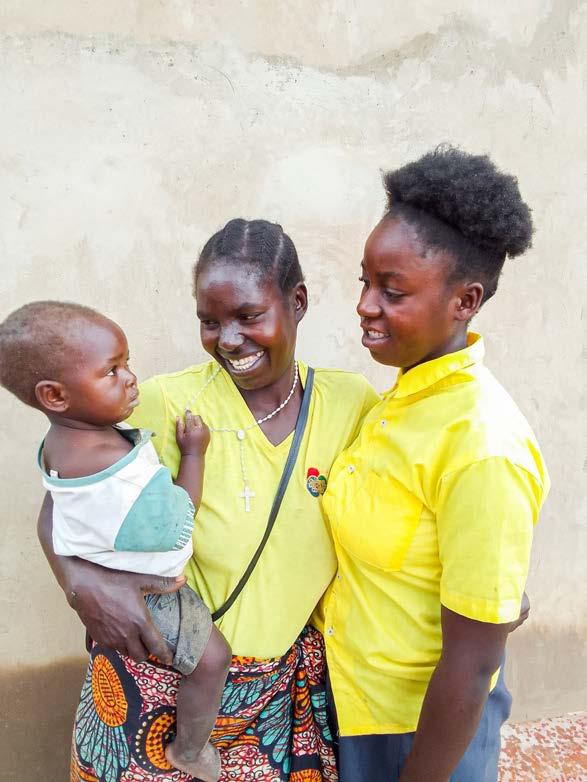
In multiple countries, like Afghanistan, Burkina Faso and Somalia, we provided child protection case management support to individual children who had experienced violence, abuse, neglect or exploitation. We ensured that these girls and boys were identified and received support, including psychosocial support and referrals to services, in a gender-sensitive and disability-inclusive manner. To ensure quality, we trained caseworkers
and community child protection networks, which are crucial in identifying and referring vulnerable children to case management support.
We also supported the revision of eligibility criteria based on vulnerability assessments, carried out service mappings and developed referral pathways as well as strengthened ’Standard Operating Procedures’ for case management that defines guiding principles, procedures and roles and responsibilities.
Children in Zambia took part in engagement meetings addressing online and offline child protection issues ranging from cyberbullying to sexual abuse. The events were used for raising awareness about child protection structures, including reporting mechanisms.
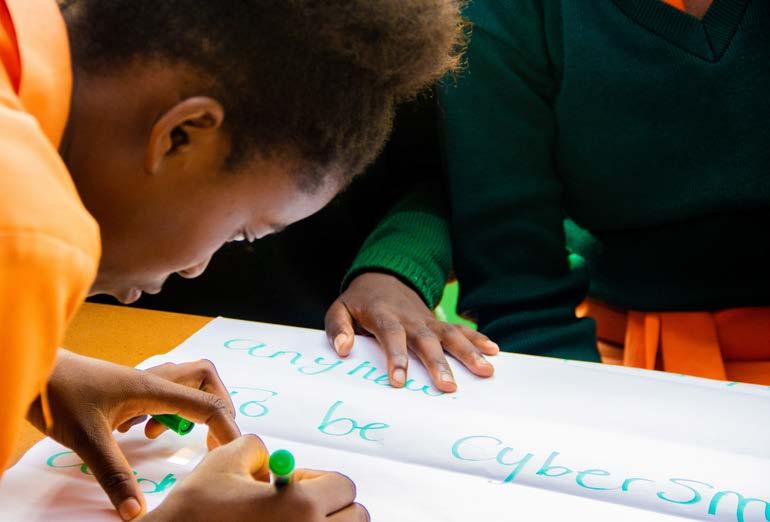
We measure annually the satisfaction of services the children and their caregivers receive. Assessments on satisfaction show a clear improvement from the baseline in our target countries (for instance, in Somaliland from 45 % to 75% and in Burkina Faso from 77% to 100%). Yet, in some countries, like Zambia and Côte d’Ivoire, case management support provided by the projects directly is limited, and therefore also the number of completed cases is still few.
Based on comprehensive quality assessments, more hands-on support is needed for government-led case management systems as well as for the delivery of services by state social workers. In rapidly changing humanitarian contexts, like in Burkina Faso, Somalia and Sudan, it is important to continue responding quickly and appropriately to the high number of displaced children and their families.
All projects have started providing and supporting both prevention and response CP services. In 2022 we reached 4 623 girls, 3 798 boys, 2 262 women and 2 998 men with CP prevention and response services. Of the aforementioned, 510 were persons with disabilities. Reaching persons with disabilities and younger women below the age of 30, requires more attention.
Baselines showed the importance of our work in improving the level of trust among children and adolescents in need of help, when they approach formal and informal service providers. On average, only 28% of children and adolescents are willing to ask for help and know a place where to get assistance in cases of emotional, physical or sexual violence. In Zambia, the number is 0% and in Burkina Faso 1%. This indicator will be measured next time at the midline of the projects.
PROGRESS TOWARDS OUTCOME 2: Children are able to grow in violence-free environment
We integrated the ‘Safe Families’ programming in all of our interventions, including sessions with children to build their resilience with caregivers to strengthen their parenting skills. Emphasis was put in using positive parenting, home visits as well as activities with communities to promote the right to live free from violence.
The programme started in four countries (Burkina Faso, Côte d’Ivoire, Zambia and Somalia/Somaliland), in both development and humanitarian settings, reaching 230 girls, 213 boys, 183 male caregivers and 375 female caregivers. Results from the first-year implementation show that on average 74%
of the children participating in the ‘Safe Families’ programme have improved their psychosocial wellbeing, and 73% of them report having improved positive interaction with their caregivers. Particularly children with disabilities show a major increase (100%) in their well-being. Although, the number of children with disabilities participating is still lower than our target.

In caregivers’ use of non-violent disciplining methods, the change is moderate: On average only 14% report using non-violent methods. Nevertheless, it’s worth noticing that across the countries the baseline was 0%.
In order to improve the male caregivers’ engagement, various strategies have been used depending on the context: In Somaliland, there are separate fathers/male caregiver groups, in Zambia a men’s network encourages male participation, and in Burkina Faso, a mixed groups of female and male caregivers facilitated understanding between gender roles while improving the communication among couples.
Baselines showed relatively low confidence among community members in their ability to prevent and respond to child protection risks. The four target countries scored 1.79/4.00 on average, which confirmed the importance of our work in this result area.
PROGRESS TOWARDS OUTCOME 3: CP laws, policies and structures are strengthened to promote zero tolerance for violence against children
Two important child protection laws were finalised in 2022: the ‘Child Right Act’ in Somaliland and the ‘Children’s Code Act’ in Zambia. Save the Children and its national partners played a crucial role in advocating and supporting both legislations and contributed to their content. The work was done in collaboration with other child rights actors in the respective countries and started already during the previous programme period.
Only 21% of formal child protection service providers and 5% of informal service providers met the minimum standards in service provision at baseline in 2022. Improvement plans have been developed together with the service providers based on the
assessments, and progress will be measured at midline. Most improvement is needed in informal service providers’ referral & case management and with formal providers’ service responsiveness. All service providers need to better their standards related to child safeguarding, child participation and privacy. In 2022, we conducted two studies —on girls’ domestic work in Côte d’Ivoire and on children’s access, use and the experiences of digital technology and the internet in Zambia— providing recommendations for policy and legislation for the children themselves, their teachers and for parents and caregivers.
Key strategies for sustainability
We work to build child protection systems at the national level for results to be upscaled and maintained. We invest in capacity building of the social workforce and support coordination mechanisms at local, regional and national levels to ensure there is no duplication among different actors and that the child protection system is well integrated with other sectors, such as education and health. In some countries, like in Zambia and Burkina Faso, we engage with the governments’ decentralisation structures
to advocate for child protection capacities and resources.
In both, developmental and humanitarian context, we work with national partner NGOs and networks. We embrace the localisation agenda to facilitate humanitarian access where it’s difficult to reach the most vulnerable and marginalised children. We work very closely with communities as a part of the child protection system to ensure ownership and support violence free environment.

Key thematic learnings
It is important to develop conflict-sensitive programming. In unstable countries impacted by insecurity, conflict and displacements, such as Afghanistan, Burkina Faso, Somalia and Sudan, we must be able to understand the context, adapt and find alternative strategies and approaches when planned activities are not possible.
Our two technical child protection advisors are a part of global working groups called ‘Safe & Appropriate Care’ and ‘Child Protection Systems Strengthening’. Through this participation we are able to provide input on global-level tasks while having an impact on the whole Save the Children movement and bring learnings from the global level to Save the Children Finland.
A. Protecting girls from exploitation - Case Côte d’Ivoire
In 2022, Save the Children carried out a study on the phenomenon of girls’ urban migration in Bondoukou and Tanda, which are poor rural districts situated in the north-east of Côte d’Ivoire. This study allowed us to better understand why girls, aged 10 to 17, migrate to towns, and what risks and dangers they face, so that we can develop targeted and tailored approaches to address the issue.
The main cause of girls’ migration is the high level of poverty, which tends to lead to parents giving their daughters away as domestic workers. Simultaneously, the households in urban areas consider the girls as submissive and hardworking, and therefore prefer to employ them.
The study identified 3 main profiles:
1) Young girls with little or no schooling, working as servants for an indefinite period of time, and whose salary is paid to their parents or other adults;
2) Out-of-school girls who aim to resume studies, vocational training or to start an income generating activity, and whose time in domestic work is defined by the amount of money required for their future project;
3) Young girls who are in school and migrate during the school holiday period and work to ensure that they can manage school expenses for the next school term. All girls faced multiple risks and harm from physical, verbal and sexual abuse to exploitation by their parents and/or other adults facilitating the migration.
The key recommendations consist of 1) informing the girls engaged in domestic work about their rights, 2) encouraging them to report violence and exploitation while providing case management support when needed, 3) supporting mothers and caregivers with income-generating activities to help cover the girls’ education expenses, and 4) conducting mass campaigns in urban areas on risks and consequences of child exploitation.
B. Progressive ‘Children’s Code Act’ protects children comprehensively - Case Zambia
The ‘Children’s Code Act’ was enacted in Zambia in August 2022. The Act protects child rights and children’s wellbeing comprehensively by for instance prohibiting child marriage, female genital mutilation, corporal punishment and child labour. It introduces child safeguarding procedures for all services and organisations working with children to ensure that all children have avenues in place to report cases of violence, be it physical, sexual or emotional, and the right to services and parental care.
The Act is progressive and aligned with international child rights standards like the ‘UN Convention on the Rights of the Child’. Save the Children actively participated in advocacy for enactment of the Act by influencing parliamentarians and other decision-makers, in the legislative review and validation processes, and also contributed to the content of the Act.
The Act is critical as it emphasises the Zambian Government’s commitment to eliminating violence against children in all forms and in all settings: at home, in schools, in institutions and online.
3.4. Food Security, Livelihoods, Cash and Voucher Assistance
The implementation of unconditional cash transfer demonstrated positive impacts on food consumption among crisis-affected populations in 2022. Through these transfers, the purchasing power of the affected communities increased, enabling them to access food and other essential items and services.
The ‘Village Saving and Loans’ (VSLA) project in Somalia successfully built economic resilience and enhanced women’s empowerment while helping rural communities access financial support and credit facilities.
Save the Children has adopted a flexible approach and programming in the humanitarian response efforts. This includes quickly adjusting transfer values and diversifying financial service providers to respond to changing circumstances on the ground. This approach helps to ensure the access to essential resources and services in times of crisis for the most vulnerable populations.
PROGRESS TOWARDS OUTCOME 1: Improved access to food for food insecure families
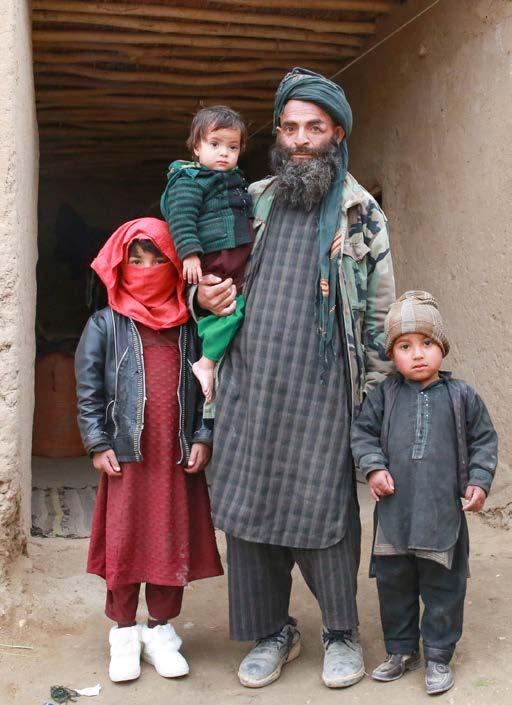
The Multipurpose Cash Assistance awards, for example, in Somalia, Sudan and Burkina Faso have shown a significant increase in the household food consumption score: After the cash assistance, the proportion of households with acceptable diet rose on average from 28% to 64% (from 24% to 82% in Burkina Faso, 32% to 64% in Sudan and from 18% to 47% in Somalia). This indicates that the unconditional cash transfers have been effective in achieving their objectives.
Despite the increase in food consumption score in all partaking countries, the set targets were not always met due to various challenges faced internationally. One of the major obstacles was the soaring inflation in developing countries, with Sudan at a record high of 88%. Additionally, the increases in
Save the Children provided cash assistance to Hafiz, a father of five in northern Afghanistan. Through this support, Hafiz could purchase food and heating materials during the harsh winter. All in all, 870 most vulnerable and needy families were supported to meet their basic needs in the province of Sar-e-Pul.
prices, such as the doubling of staple food prices in Somalia in 2022, have further impacted the project’s objectives. A sharp currency depreciation in Afghanistan, and the insecurity resulting in displacements and pressure on markets in Burkina Faso, also contributed to the challenges faced by the project.
PROGRESS TOWARDS OUTCOME 2: Improved wellbeing of children through child sensitivity interventions
The Multipurpose Cash Assistance recipients in Sudan, Somalia and Burkina Faso reported positive outcomes. After the monthly entitlements, the beneficiaries’ ability to meet their basic household needs improved and left them less stressed: For instance, in Somalia 9% of recipients feel their children’s safety increased thanks to the cash transfers. More than 85% of households in all participating countries reported cash assistance deliveries as safe, accessible, accountable and participatory, even in a volatile and insecure context.
According to need, Save the Children coupled cash transfers with other complementing activities, such as livelihood support, child protection services, family budgeting sessions, child feeding, appropriate care practices, prevention and response to violence and abuse as well as ‘Parenting Without Violence’ packages.
Key strategies for sustainability
A sense of (local) ownership and commitment is the key to long-term sustainability in humanitarian interventions. This is fostered by involving local communities in the planning and implementation of projects. Cash assistance supports local economies and enables beneficiaries to make their own choices about meeting their needs. Shifting power dynamics and prioritising the dignity of beneficiaries helps to ensure that interventions become more responsive, accountable and effective also in the long run. This is illustrated in the following examples.
A. Village Saving and Loans - Case Somalia
In Abudwak in Somalia, we established and trained five VSLA groups with 101 members (98 female, 3 male) in five internally displaced persons’ camps. As
a result, the members started taking out small loans to meet consumption needs and to invest in petty trade activities such as selling milk and vegetables and running tea kiosks. In parallel, we trained the participants, local authorities and partner staff for instance on the VSLA concept and approaches, leadership, social funding, share purchases and credit policies.
The project was successful in building economic resilience and enhancing women’s empowerment while promoting gender equality and protection through VSLA groups. The women participating in VSLAs received better opportunities to enhance their business skills and decision-making power. This local microfinance facility helped rural communities access financial support and credit facilities, enabling them to maintain their monthly savings even after the completion of the project.
B. Cash for shelter - Case Burkina Faso
In Burkina Faso, Save the Children provided shelter building assistance to internally displaced populations using the cash and voucher modality. We provided 1 135 households with vouchers to purchase construction items in the local market along with in-kind tools. Heads of households were trained on basic shelter construction techniques, ‘build back safer’ methods and good shelter maintenance practices, and were accompanied by a team of engineers, shelter specialists, animators and community leaders. This initiative had a multiplier effect on the local economy by supporting local traders with a cash injection through vouchers, even in a volatile and insecure context.
3.5. Education
In 2022, our Education in Emergencies work focused on Sudan. The larger consortium project together with Norwegian Refugee Council received an extension and an increase in the budget from the Directorate-General for European Civil Protection and Humanitarian Aid Operations (DG-ECHO)
now totalling nearly 8 million euros. The consortium partners Save the Children Sudan and Norwegian Refugee Council have started the implementation of the project in all targeted states, and altogether 163 education facilities are being established.

PROGRESS TOWARDS OUTCOME 1: Improved access to education services – especially in emergency setting
# of targeted girls and boys enrolled in formal education services: 47 608 (26 184 female and 21 424 male)
# of targeted girls and boys enrolled in non-formal education services: 2 700
Save the Children International and Norwegian Refugee Council have reached 47 608 (26 184 female and 21 424 male) children during the programme period. This is mainly a result of the improvements in the basic infrastructure of the schools and quality of education materials given to children, which encourages caregivers to send their children to the schools. The ‘Accelerated Education Programme’ reached 2 700 children, with 41% of them being able to transition into formal education. The project also conducted a successful ‘Safe Back to School’ campaign exceeding enrolment target in all project locations in Sudan.
Security and safety remain among the main challenges facing the project implementation in West Darfur. The tribal conflict in Blue Nile resulted in preventing nearly 3 200 children from accessing education due to displacement, and over 5 300 due to the use of schools as safe shelters for the displaced people. In both Blue Nile and West Darfur states, schools have been occupied by armed groups.
Despite these challenges, the ‘Safe Schools Declaration’ was signed in October 2022 by different armed groups and military fractions together with the government. The groups agreed to evacuate occupied schools by December 2022. The political and economic challenges have additionally hampered the education sector, along with a 30-day teachers’ strike during the reporting period, which disrupted the education process and project implementation.
Key strategies for sustainability
To enforce sustainability, whenever possible, Save the Children International continues to work within the existing education system and in close co-operation with the local ministries of education. The
community-based approach remains an important cornerstone to the Education in Emergencies work implemented in Sudan.
In terms of the political situation, there was considerable turmoil due to the emergence of tribal conflicts in different parts of the country. Instability and political unrest are commonplace in Sudan, which limited the accessibility and movements of school children. To address this, the project mapped the situation and developed a remedial support plan. Additionally, Save the Children International has plans to roll out the ‘Safe Schools Declaration’ in three states: West Darfur, Blue Nile and South Kordofan.
A workshop was conducted in West Darfur, where more than 30 bodies signed a ‘State Commitment’ to protect school education from occupation and end attacks on education. The signatories included military forces, inattention organisations, UN agencies and community leaders.
The project has also capitalised on the community and built their resilience by capacitating them to prioritise education as lifesaving. To this end, in all areas where conflict emerged, the community has supported and participated in ensuring a protective and safe environment for children and encouraging the quick start-up of learning.
Fatima is a midwife working at a health clinic supported by Save the Children in North Darfur, Sudan. “Less women are dying now, because of the support they receive from the health centre, from myself and my colleagues. I am so grateful for that.” More than 195,000 children and an equal number of adults were reached through the EU funded Health and Nutrition projects of Save the Children Finland.
3.6. Health and Nutrition
Save the Children Finland continued the implementation of the ‘Health and Nutrition’ programme in 2022. Lifesaving health and nutrition services were delivered to 193 600 people through two ECHO funded projects in South Kordofan, West Darfur, North and Central Darfur, Blue Nile and Khartoum.
The projects were addressing the health service supply and demand challenges by improving the quality of services through
1) training,
2) essential medicine and supplies,
3) facilities’ infrastructure,
4) community engagement,
5) integrated ‘Community Case Management’ in communities, and
6) referrals to high-level medical care and non-medical services.
PROGRESS TOWARDS OUTCOME 1: Improved access to health and nutrition services
During 2022, nearly 10 100 malnourished children were admitted in the nutrition programmes: 8 350 were suffering from moderate acute malnutrition and 2 632 severe acute malnutrition. All cases received treatment and necessary medical support.
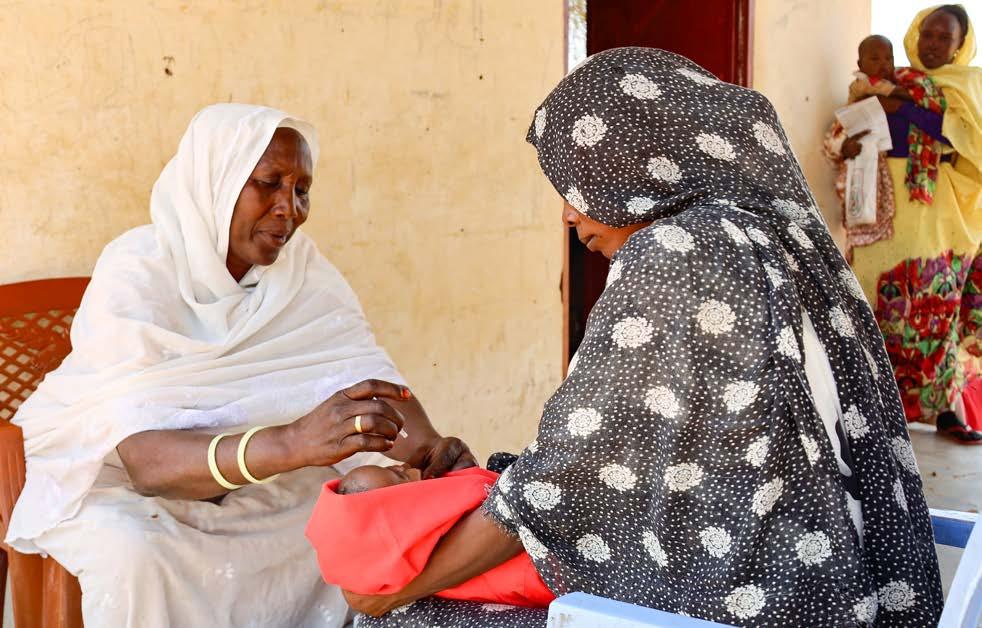
Save the Children International supported the provision of comprehensive nutrition services to children under five years as well as pregnant and lactating women. The services included treatment, referrals, staff training and the promotion of ‘Infant and young child feeding’ practices through mothers’ groups.
As a result of Save the Children’s awareness raising activities 8 240 deliveries were attended by a skilled birth attendant (vs. traditional birth attendant) in 2022. This was achieved mainly by providing incentives, such as clean delivery kits, to women who attended regular antenatal care. Save the Children International signed Memorandums of Understanding with secondary levels of care and supported complicated and high-risk pregnancy referral processes in addition to costs of medicine and medical tests when not free at the hospital. In total, 35 cases were referred for possible surgical intervention.
Save the Children supported the national rollout of COVID-19 vaccinations in the targeted areas, reaching nearly 472 900 (33% female, 66% male) beneficiaries. The popularity among male population is partially down to male movement in general, but there was also a widely spread rumour across Sudan about the vaccine causing infertility.
Key strategies for sustainability
Save the Children’s commitment to implementing the programmes with partners and capacitating them, is one of the most effective mechanisms to ensure medium and long-term sustainability. Save the Children provided and implemented a comprehensive capacity building plan, on-the-job training and exposure visits to strengthen the local partners to deliver quality services. Save the Children International also supported the government staff to monitor the activities and develop their capacity through joint-supervision, frequent training and mentoring. These competences contribute to the resilience building and self-protection of civilians and local communities.
Save the Children participated in coordination meetings at both the state and national levels and worked closely with the existing community structures to promote community ownership and sustainability. Save the Children supported the health cluster by recruiting and deploying a health coordinator and worked with the government to ensure the sustainability of the project outcomes after phasing out.
Women waiting to receive assistance at a health centre of Save the Children in Baidoa, Somalia.

4. CHILDREN’S RIGHTS AND BUSINESS AND CORPORATE PARTNERSHIPS
The 10th anniversary of ‘Children’s Rights and Business Principles’ (CRBP) in June 2022 marked an important milestone for Save the Children, UNICEF and UN Global Compact. The jointly developed CRBPs were the first comprehensive set of principles to guide and engage companies in corporate responsibility towards children.
Even though the voluntary corporate actions to embed the CRBP into sustainability strategies and operations are unfortunately still rare, luckily, Save the Children Finland has gotten the opportunity to work with a few global forerunner companies to take on the CRBP and to promote it in the Finnish corporate ecosystem.
As an example, Save the Children Finland investigated together with Save the Children Bangladesh, the realisation of women’s and children’s rights and family-friendly operations in textile production in Bangladesh on behalf of the Finnish S Group, a network of companies in the retail and service sectors. With Nordic telco Telia, Accenture Finland, Microsoft Finland, Gigantti and Google Foundation, Save the Children Finland joined forces to promote child
rights and to protect children in the digital environment.
Programmatic corporate partnerships were carried out for instance in India, where a global energy utilities company Fortum supported the post-COVID recovery in Rajasthan by helping children and their families to overcome the impact of the pandemic. Similarly, an investment company Athensmed supported the health and nutrition activities in Sudan. Additionally, some globally oriented foundations, including the Greta Maria Lindblom Foundation and the Red Nose Day Foundation, supported child protection work in Côte d’Ivoire and Sudan.
The escalated war in Ukraine directed the Finnish corporate social sustainability interest in 2022 heavily on humanitarian response. Companies supported Save the Children International’s work in Ukraine and in the neighbouring countries as well as in Finland to help the victims of the war.
INCREASING TRANSPARENCY AND LISTENING TO WORKERS’ VOICE:
The Finnish retailing cooperative S Group was supported to conduct an independent evaluation of the realisation of women’s and children’s rights as well as family-friendly operations in textile production in Bangladesh. The assessment resulted in a series of recommendations on how S Group can further child rights in business and bring about a positive change for the family friendliness within its readymade garments supply chain in Bangladesh.
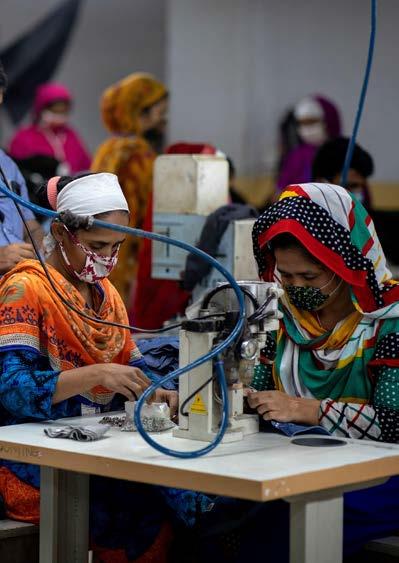
5. CROSS-CUTTING THEMES
5.1. Gender Equality
Save the Children Finland aims at ensuring that the data collected to measure the results of our work is presented disaggregated by sex. For the vast majority of the projects for which baseline studies were finalised in 2022, this objective was met. The second milestone was to identify gender inequalities, their root causes and gender transformative approaches, such as in the examples below, to address the issues at project level.
Parenting and caregiving responsibility is left for mothers/female caregivers with limited involvement and support from fathers/male caregivers due to cultural norms. Both CSSP and CP projects engage fathers/male caregivers in parenting sessions either by organising sessions for men separately or by reaching out to them through influential men’s networks and male role models. CSSP parenting package also includes separate gender and saving & budgeting sessions that promote women’s decision-making at the household level.
The prevalence of sexual and gender-based violence is high and rarely reported, but handled by the community and religious leaders instead, impacting specifically girls. This is due to the stigma of reporting, cultural acceptance of violence against children and women and the learning of gender roles and masculine/feminine stereotypes by girls and boys from an early age. CP projects in Burkina Faso, Côte d’Ivoire,
Gender sessions are integrated into the parenting program for recipients of the 4Ps social protection scheme in the Philippines. A special parenting course for fathers and male caregivers has also been developed.
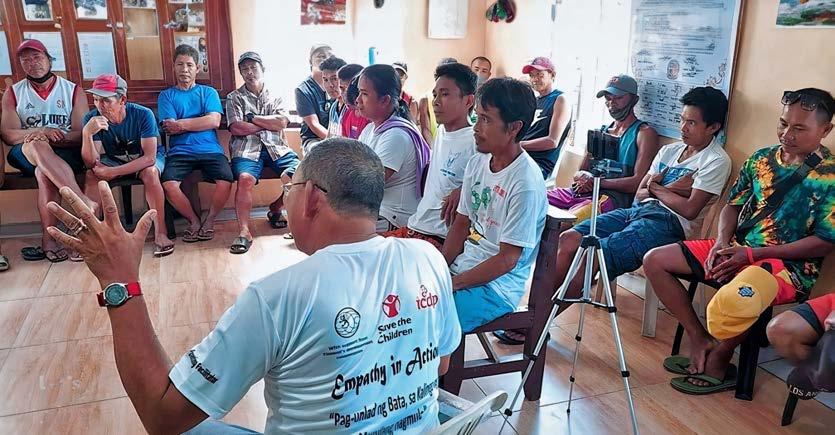
Somalia and Zambia support CP case management by, for instance, providing better support for survivors of sexual and gender-based violence, establishing desks for this topic at the community level (in Somaliland), organising community dialogues and awareness raising campaigns, engaging religious and community leaders and by working with girls, boys and youth groups to challenge unequal and harmful gender stereotypes. In Somaliland advocacy efforts are made for the enactment of a Sexual Offences Bill.
Many micro-projects focus on the commercialisation of agricultural products and the design and marketing of tools to facilitate domestic tasks. As these kinds of jobs are traditionally held by men, girls and women are left out of traineeship programmes and entrepreneurial micro-projects. In Côte d’Ivoire this was tackled by supporting girls’ access to training and funding for micro-projects to support the businesses of their preference. This has ensured that 28% of traineeship and 67% of micro-projects participants are girls and women.
Based on the feedback received from the country offices, the Save the Children Finland’s gender equality situational analysis tool was revised in 2022 to make it simpler and to improve the guidance for tool utilisation.
The family of Sahid (9) and Sabana (7) was previously unaware of Nepal’s disability allowance. Through Save the Children’s CSSP project, the family was supported to access this social protection scheme, greatly improving the living conditions of their children.
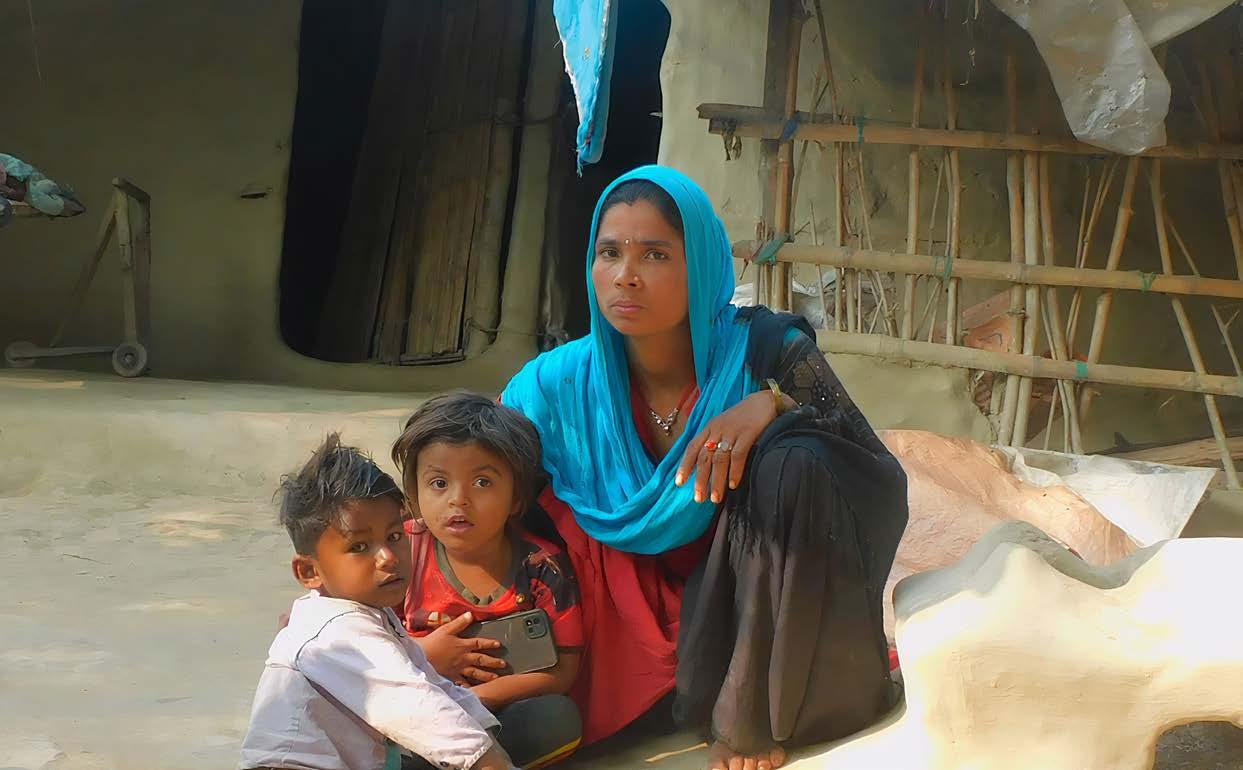
5.2. Disability Inclusion
Baseline studies undertaken in 2022 aimed to include disability-disaggregated and gender-disaggregated data. A milestone set for 2022 under disability inclusion was to ensure the projects funded by the Programme-Based Support from the Finnish Ministry for Foreign Affairs use question sets developed by the Washington Group on Disability Statistics where it was relevant. This is done to determine the type and extent of persons and children with disability, when undertaking baseline, which was achieved.
In the context of promoting disability inclusion in CSSP programming, disability inclusion sessions were developed and implemented as part of the parenting package based on the International Child Development Programme in Somaliland. This was widely appreciated at the community level and has encouraged us to consider including sessions in other CSSP projects as well. Under CP, sessions to
promote disability inclusion were initiated within the framework of the ‘Parenting without violence’ approach.
The Save the Children Finland’s disability inclusion promotion tool was additionally revised in 2022. Further simplification needs to be done to make the tool more user friendly. This will be pursued during 2023 with the support from the Disability Inclusion Technical Working Group at Save the Children International.
Save the Children Finland’s engagement and partnership with Abilis Foundation, a Finnish non-governmental organisation promoting the rights of persons with disabilities, continued during 2022. Their technical support over the last few years has been instrumental in bringing the focus on disability inclusion in our international programmes.
5.3. Climate Change Adaptation
Save the Children Finland has taken a proactive step by integrating ‘Climate Change Adaptation and Disaster Preparedness’ into all humanitarian projects, encompassing both development and humanitarian initiatives. This strategic approach ensures that climate change and disaster risks are addressed comprehensively, aiming to enhance resilience and minimise vulnerabilities in the communities they serve. Notably, Save the Children Finland has recognised the significance of flexibility in emergency funding for humanitarian projects. By building adaptability into the interventions, projects are better equipped to respond swiftly and effectively to both foreseeable and unforeseeable shocks, including those triggered by natural disasters and human-induced crises.
For example, in our development and protection project in Somaliland, we aimed at enhancing community resilience in the face of drought, fire outbreaks and floods: We provided awareness sessions to the community about fire hazards and the risks of children being left unattended. Flood risks were
addressed near bridges and water passages, and key messages on hazards and their impact on children were distributed. Additionally, we provided support to prevent school dropouts, child labour and early marriages. Children affected by the drought were given case management or referred to other projects.
In Sudan, Save the Children International is the largest partner funded by ECHO in terms of emergency funding. These awards encompass various modalities which enable a rapid and tailored response that aligns with the prevailing context and needs, as they are based on scenario building and analysis of the context. One such modality is the crisis modifier, which is planned in advance and allows for agile and flexible adjustments to the project activities in case of an emergency. This allows Save the Children International to effectively address emergencies and provide timely assistance to those affected.
Members of a child club supported by Save the Children in Burkina Faso conducting a risk mapping. Through the identification of threats, vulnerabilities and capacities, the children contribute to the efforts of their communities, for example, to adapt to climate change and mitigate related risks.
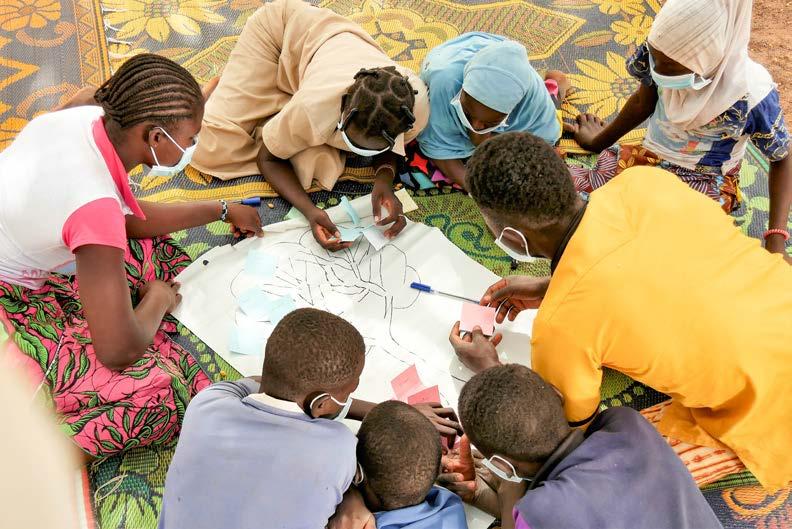
6. COMMUNICATIONS AND ADVOCACY
Through programme and development communications, media work and global education, diverse efforts were undertaken to raise awareness and understanding of the development issues related to child rights and the programme work of Save the Children.
Communications in 2022 focused on the programming themes of Save the Children Finland. Executed public campaigns highlighted various aspects of child poverty and inequalities, child protection and access to education as well as climate change, hunger and conflicts. All available communication channels, in addition to those of partner organisations, were utilised to communicate programming progress, results and impact to supporters, stakeholders and wider audiences.
The regularly issued newsletters, updates and the magazine of Save the Children Finland were disseminated to 2 000 - 60 000 households and other recipients, depending on the target audience and type of material. Communications activities also included the publishing and the dissemination of research papers, evaluations and impact reports produced as part of Save the Children Finland’s programming. Special attention was given to the themes of child poverty (CSSP) and protection.
Extensive media and engagement work was conducted in order to reach wider audiences, influence public opinion and to promote debate. Visibility in media was at record high, with almost 1500 hits recorded by the end the year.
Save the Children Finland has focused on developing new ways of reaching and engaging audiences. In 2022, Save the Children Finland had a social media presence on Facebook, Twitter, Instagram and LinkedIn. The content on social media channels reached altogether over 9.6 million people. Attention was paid to creating engaging content that was informative, but also visually and emotionally appealing. This resulted in nearly 886 000 engagements across the channels. Both, the reach and the
The Global Girlhood Report 2022: Girls on the Frontline was one of the flagship publications of Save the Children that was widely reported upon by the media. This edition investigated gender equality and girls’ rights with a focus on the effect of conflict on child marriage.

engagement through social media channels increased significantly compared to 2021. In 2021 our social media content reached 8,5 million people and in 2022 already 9,6 million people. In 2021 our social media content had 578 900 engagements and in 2022 nearly 886 000 engagements.
The advocacy objectives in 2022 were to strengthen both, the role of social security in development policy in order to reduce inequalities caused by poverty, and the focus of protection of children as a specific group in humanitarian situations and conflicts. The
right to education was a cross-cutting theme in both goals: Access to school in a crisis situation strengthens the protection of children and, on the other hand, social security in developing countries supports the basic needs of the children and their families, often enabling them to attend school. The third focus area for influencing was Finland’s development co-operation funding. We worked very closely with other organisations to resist the planned cuts during both, the spring government spending framework discussion and the budget negotiations in the autumn.
We worked towards the objectives by organising both virtual and live events, delivering numerous expert speeches at various events, seminars and government hearings, by writing opinion pieces and statements and actively participating in various networks.
A significant amount of time was spent in meeting politicians and civil servants to communicate Save
the Children Finland’s positions for the upcoming parliamentary elections. In addition to the war in Ukraine, among other discussed topics were country-specific violations of the rights in Afghanistan, Yemen and Syria in particular.
The important advocacy successes of our programme countries in 2022 came from Zambia and Somaliland. In Zambia the ‘Child Act’, which had been in the works for 20 years, was finally adopted by the country’s parliament. In Somaliland, the Child Act was approved after over 10 years of advocacy efforts. Save the Children, and its national partners supported both processes in many ways over the years, and these results of long-term advocacy make a significant difference in the lives of Zambian and Somaliland children.
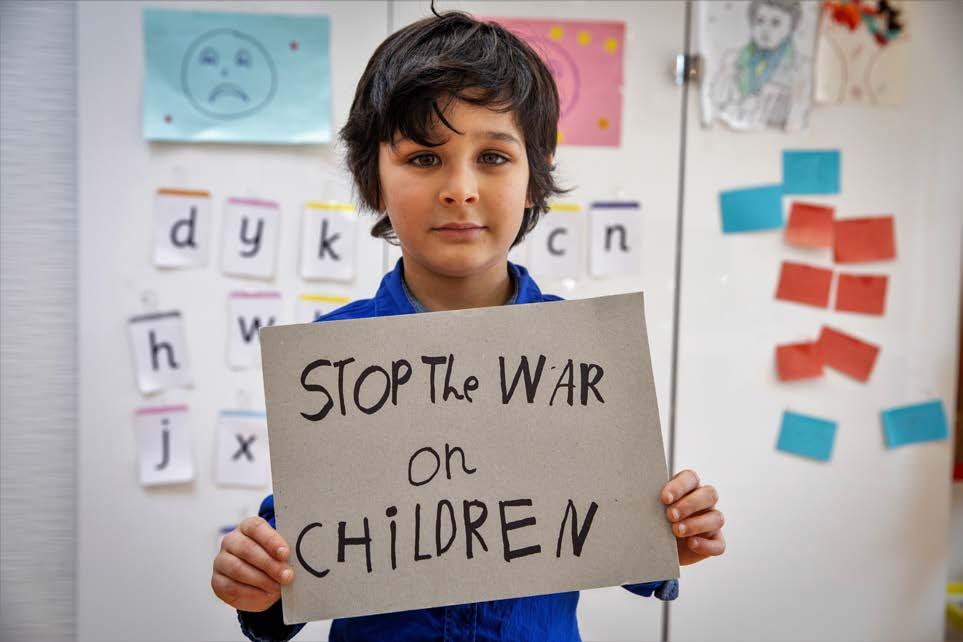
Creating positive, irreversible change for and with children. Save the Children believes every child deserves a future around the world, we do whatever it takes –every day and in times of crisis – so children can fulfil their rights to a healthy start in life, the opportunity to learn and protection from harm.
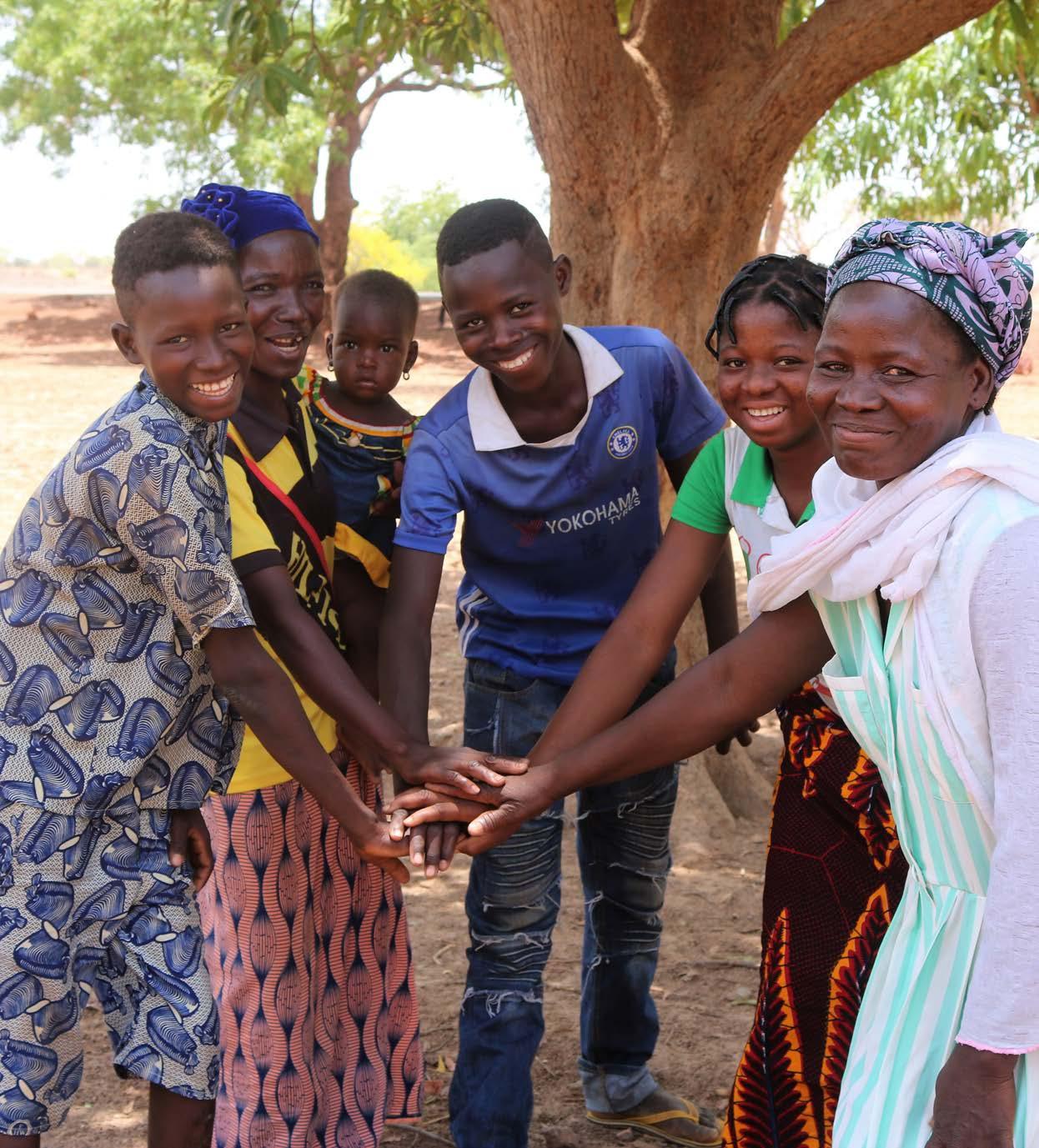
OUR VISION
A world in which every child attains the right to survival, protection, development and participation.

OUR MISSION
To inspire breakthroughs in the way the world treats children and achieve immediate and lasting change in their lives.
OUR VALUES
In all that we do, we will demonstrate our values of Accountability, Ambition, Collaboration, Creativity and Integrity.


